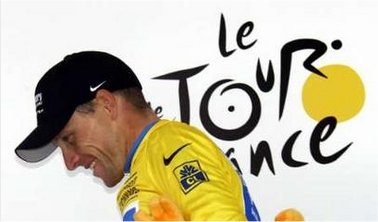July 23, 2005
REVELATIONS FROM 'DEEP TIRE'

On the day of the last most important stage of Lance Armstrong's cycling career, his bike has an admission to make:
I feel sort of like Mark Felt on this one, revealing a long-held secret between Lance and me. But I think the time has come to let the world know. Call me Deep Tire.You remember the famous stage in 2003 when Lance and I fell to the ground after some kid stuck out his bag and got tangled with my handlebars? Remember how Lance got back up and valiantly caught up with the field and pulled off a dramatic victory? It was pretty heady stuff.
Bet you’d never guess that we staged the whole thing. Sure did. It was my idea, too.
Lance and I were having a blast on that 2003 Tour. First, he faked a case of dehydration in the opening time trial just to make his rivals think he was weak. Then, I used a nail in my front fork to pop Joseba Beloki’s tire going down a mountain descent, allowing Lance to appear to ad-lib it on a little off-road adventure. We actually planned that little detour two months earlier when we scouted the route. “It’ll look great on TV,” Lance said conspiratorially. “Trek will love it.”
We were on a high from all the media coverage that little stunt brought, so I decided to do it again. When we were climbing up to Luz-Ardiden, I spotted the kid and his bag to my right. I swerved into him, snagging the bag with my right handlebar. Boom! Down with Lance, with Iban Mayo right on top of him. The rest is Tour de France history.
It did look great on TV.
I hope history will be kind to Deep Tire.
In more serious news, it is difficult to appreciate what winning seven Tour de France races means without understanding how Armstrong has taken advantage of his unique physiology:
Edward F. Coyle of the University of Texas-Austin found out about Lance Armstrong was that from 1992-1999, the year of his first of now six consecutive Tour de France wins, “the characteristic that improved most (was) an 8 percent improvement in muscular efficiency and thus power production when cycling at a given maximal oxygen uptake.”Combining the increased muscular efficiency with a planned 7 percent reduction in body weight and fat leading up to each Tour de France race, “contributed equally to a remarkable 18 percent improvement in his steady-state power per kilogram” output, the Coyle paper reported.
In other words, he lost weight but gained muscle and improved his power. More muscle + less weight = demon speed.
Whereas the lab tests were held constant at 85 revolutions per minute (rpm) for comparison purposes, Armstrong’s “freely chosen cycling cadence during time trial races of 30- to 60-minute duration increased progressively during this year period from about 85-95 rpm to about 105-110 rpm.This increase in freely chosen rpm when cycling at high intensity is indeed consistent with increase in type I muscle fibers because cyclists with a higher percentage of type I fibers choose a higher pedaling cadence when exercising at high power outputs,” the report said. “Although this may initially seem paradoxical, higher cycling cadence serves to both bring muscle fiber contraction velocity closer to that of maximum power and reduce the muscle and pedaling force required for each cycling stroke,” it noted.
Interpretation: Lance pedals 20 percent quicker than he used to - and quicker than most cyclists. And instead of it tiring him out, it actually makes better use of a specific type of muscle that operates more efficiently.
Coyle said increased muscle efficiency means that “for the same amount of cardiovascular and lung stress Armstrong is producing 8% more power, and yet producing less heat. These results have shown us how to improve already highly trained athletes by aiming at efficiency, which is a muscle phenomenon. But it’s also nice to know,” he added, “that as you get older that your body becomes wiser in how it does its job and less wasteful in energy usage.”
In conclusion: Holy Crap.
Not only did Armstrong pick the absolute premium sport for his body type, his body got better as it aged.
When you factor in his almost volcanic will and motivation to win, no one ever had a prayer to beat him. Not even on his worst day.
We'll never see another athlete like this during our lifetime.
Posted by Jeff at July 23, 2005 09:33 AM | TrackBack